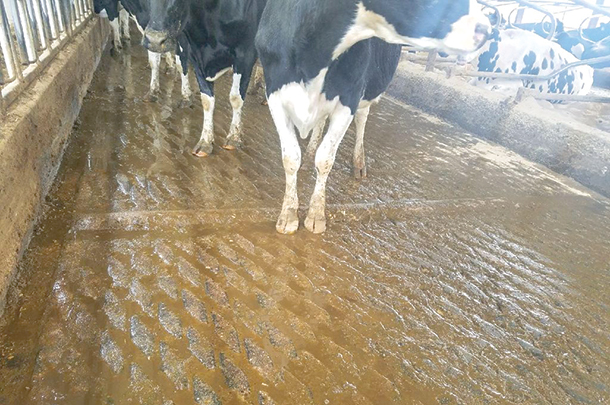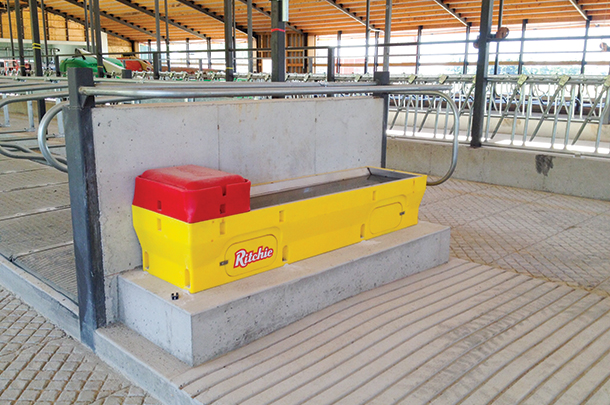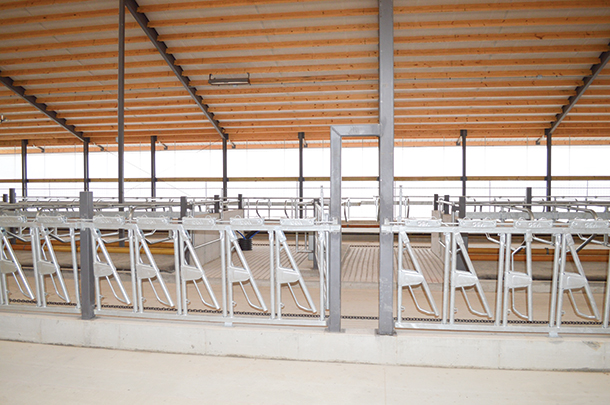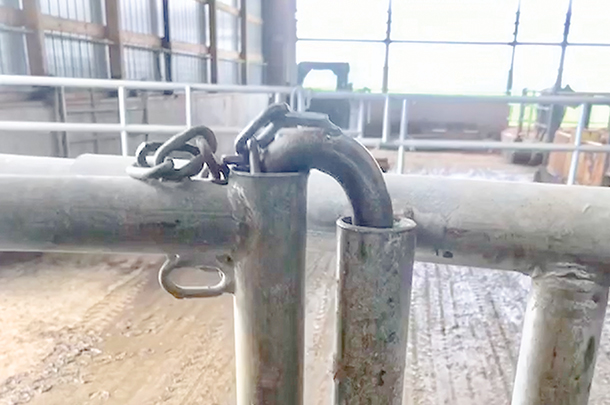To read this article in French, click here.
When building a new freestall barn, what seems like a small decision in the designing phase can make or break efficiency later on. On the other hand, a few simple tweaks can save time and stress after the barn is built.
Make your own “wish list” early in the game, taking note during your everyday operations of the little things that would make life easier. Each time you catch yourself saying, “Man, it sure would save me time if only I had this,” add that item to the list. These ideas will make the new facility much more efficient and worker-friendly.
Automated ventilation
By installing an automated ventilation system in your new freestall barn, you will eliminate the constant chase of the weather. These systems automatically adjust the barn’s fans and curtains to coordinate with the outdoor elements.
There are automated systems designed for each freestall barn style, whether it be natural ventilation, cross ventilation or tunnel ventilation. Although an added price tag comes with this add-on, it is money well spent. Typically, in a barn that does not include an automated system, a lot of time is spent adjusting the multiple curtain cranks and regulating fan speeds.
Speed bumps
Speed bumps are starting to take a new trend in freestall barns. When an operator is on a piece of equipment cleaning out the litter alleys, they are typically on a mission to get the job done. Unfortunately, if the operator is not fully engaged and aware of their surroundings, they are banging into things.
 Speed bump: By installing a speed bump close to the end of the feed
alley (typically by the watering station), skid steer operators are
notified they are close to the end of the feed alley and to slow down. Photo courtesy of Bayland Buildings.
Speed bump: By installing a speed bump close to the end of the feed
alley (typically by the watering station), skid steer operators are
notified they are close to the end of the feed alley and to slow down. Photo courtesy of Bayland Buildings.
These “came out of nowhere” bangs can rack up to cost a fair amount of change. When the operator is backing up, it is not uncommon for them to run into a gate. In turn, the gate is now junk. By installing a speed bump close to the end of the feed alley (typically by the watering station), they are now being notified they are close to the end of the feed alley and to slow it down. The extra expense to incorporate speed bumps into litter alleys is extremely minimal and will save stress and money down the road.
Steel end channels
Steel end channels are fabricated steel caps poured into the end of each of the concrete walls inside the barn such as the crossovers and watering stations. The purpose of the end channels is to protect the concrete walls from the equipment. A lot like the purpose of the speed bumps, you are protecting your barn components from the strength of the equipment during the bangs.
 End channel: Installing steel end channels can save money in the long
run by protecting interior concrete walls from skid steer damage. Photo courtesy of Bayland Buildings.
End channel: Installing steel end channels can save money in the long
run by protecting interior concrete walls from skid steer damage. Photo courtesy of Bayland Buildings.
Without the end channels, when an employee is cleaning the alleys, they make a turn and run into the concrete walls. Slowly, over time, the concrete chips away, and that small chip is no longer small. Installing steel end channels can save a lot of money in the long run by eliminating the possibility of replacing the interior concrete walls. The upfront cost is minimal compared to having to replace the walls down the road.
Man passes
Man passes are a must. Talk about saving time throughout your day every day. A man pass is an opening built into a row of headlocks which allows a person to quickly and easily pass through from the feed alley to the litter alley. This opening is correctly configured in size to eliminate the opportunity for the animals to get stuck or escape from their group.
 Man pass: Save time with a way to easily enter and exit pens with a man pass. Photo courtesy of Bayland Buildings.
Man pass: Save time with a way to easily enter and exit pens with a man pass. Photo courtesy of Bayland Buildings.The man pass will eliminate the time wasted walking down to the end of a pen, opening the gate’s latch system and entering the pen, only to reverse this series of events to get back out of the pen. Man passes are typically installed close to the watering stations to allow for easy access to clean and maintain that watering station. When calculating cost versus expenses, installing man passes is a must at such a low upfront cost.
Gate latches
Gate latches are a necessity in every freestall barn due to the number of gates in a freestall barn. When choosing your gate latches, evaluate all latch options. If a latch is not durable, it will be a constant item on the fix-it list. Be sure to choose a latch system that is solid, with minimal mechanisms.
 J-hook: Choose a latch system that is solid with minimal mechanisms, like this J-hook latch. Photo courtesy of Bayland Buildings.
J-hook: Choose a latch system that is solid with minimal mechanisms, like this J-hook latch. Photo courtesy of Bayland Buildings.The go-to for our customers is a J-hook latch. The J-hook latch is a strong, durable J-shaped piece of metal that slips into the vertical end of the gate and into a small tube welded onto the gatepost. It is attached by a linked chain to ensure the hook is always attached to the gate and eliminates the misplacement of the hook. This gate latch has no mechanical components, which eliminates the need for constant replacements of parts. It always works.
With so many decisions to make when starting a construction project, it is helpful to bring a “wish list” to the builder so you can build the barn you want. Consider incorporating some of these simple design elements to improve efficiency and reduce stress for years to come.






